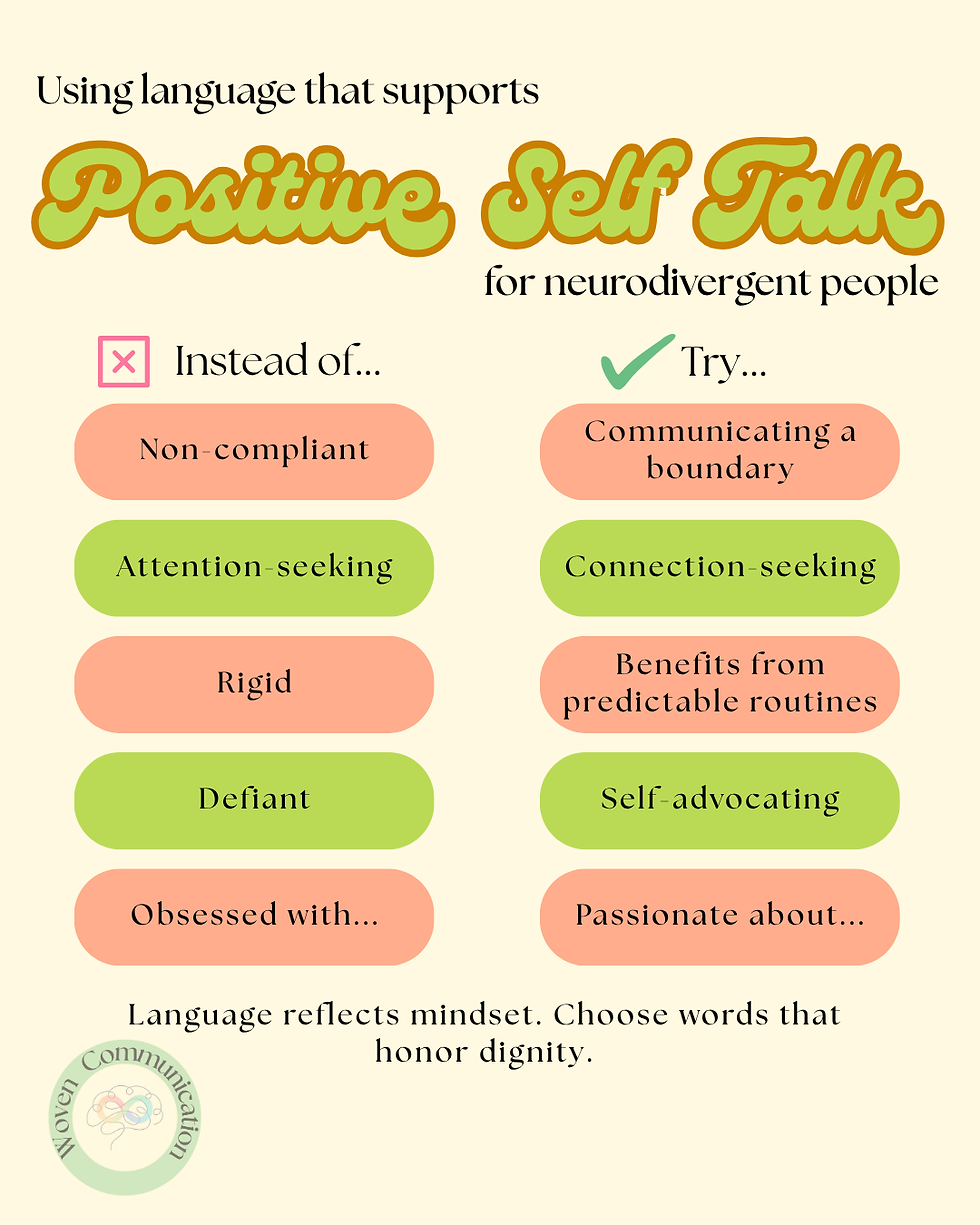Neurodiversity-Affirming Therapy: What It Is and Why It Matters
- Thomas Brown
- Jul 23
- 4 min read
By Thomas Brown, M.S., CCC-SLP

Neurodiversity is the idea that neurological (brain) differences—like Autism, ADHD, Dyslexia, and so many others—are natural variations of the human brain. Neurodiversity is not just about identifying differences in the way someone behaves or thinks; it’s a celebration of natural variety. When we talk openly about neurodivergence, it can help neurodivergent people feel less alone and build community.
Neurodiversity-affirming therapy is grounded in the core principles of respect, celebration of diversity, self-advocacy, and self-exploration. This approach does not focus on "normalization," "social skills compliance," or any other tools that pressure children to mask who they truly are. Instead, through evidence-based practices, therapists support the development of self-awareness skills that nurture problem-solving, decision-making, and impulse control.

Neurodiversity-affirming care is not just about the language we use—it’s about the actions we take. It means presuming competence: speaking to all individuals with respect and kindness, regardless of their support needs. It means honoring autonomy: respecting when a client declines and centering choice-making as a fundamental part of care. It means using a strength-based model: focusing on skills, interests, and preferred activities, and reinforcing growth through positive support. And it means collaborating with the individual—and their support system—rather than working around them.
Language is often a major focus when it comes to neurodiversity-affirming care, and while it is important to be mindful of the words we use, it’s also important to recognize that every individual has their own preferences when it comes to how they’re described. One ongoing conversation centers around identity-first language ("They are autistic") vs. person-first language ("They have autism"). I remember a powerful metaphor shared by my college professor, Amy Donaldson, that helped this click for me: Think of autism like a bag. It’s not something you can set down, store in an attic, and forget about. It’s something that lives within you and you cannot set it down. Saying “I am a bag” vs. “I have a bag (that I shoved in the back of my closet and I’m forgetting about it as we speak)” conveys two very different messages. We can’t shove autism, ADHD, or any other neurotype into the back of our mind—and we shouldn’t be expected to. This is my preference, and I honor those who prefer person first language. The best policy around this is to ask the individual what feels right to them.
One of the biggest myths I hear is that neurodiversity-affirming care means we throw all structure and expectations out the window. That couldn’t be further from the truth. Affirming care doesn’t mean “anything goes”—it means the supports we offer are collaborative, compassionate, and personalized. It means recognizing that dysregulation (when your emotions, body, or energy feel out of control and hard to manage) or avoidance are not behaviors to punish, but signals to understand. And yes—neurodiversity-affirming therapy is evidence-based. It’s rooted in the latest research on nervous system regulation, learning theory, and trauma-informed care. We can hold boundaries and be flexible. We can support growth without forcing change that undermines identity.
Why This Approach Matters
The difference between affirming and non-affirming care is not subtle—it’s deeply felt. When children are repeatedly told, through words or actions, that they are “too much,” “too loud,” “too sensitive,” or “not enough,” it chips away at their self-worth. I’ve sat with teens who’ve spent years masking at school, then come home exhausted, anxious, and unsure of who they are underneath the mask. I’ve also seen what happens when we shift the approach—when we say, “It’s okay to be you,” and actually mean it. Confidence blooms. Curiosity grows. Relationships deepen. And people begin to trust themselves again.
So, Who Benefits From Neurodiversity-Affirming Care?
Everyone. While the direct focus is on supporting neurodivergent individuals, the ripple effects of affirming care reach everyone in that person’s life. Parents feel more connected to their child. Teachers notice a reduction in power struggles. Therapists build stronger alliances with their clients. When we create environments where differences are respected and supported, the whole community benefits. We even start to be less hard on ourselves, and can adjust our own self-talk cycle. Affirming care builds bridges—between people, between systems, and within ourselves.

Final Thoughts: Keep Getting Curious
If this resonates with you, I encourage you to pause and reflect: How do I talk about neurodivergence? How do I respond to behavior I don’t understand? Am I listening with curiosity—or correction?
Neurodiversity-affirming care asks us to get curious, to seek understanding, and to lead with compassion. It’s not about being perfect—it’s about being present.
Want to learn more? Some great starting points include books like Unmasking Autism by Devon Price, following neurodivergent creators on social media, or checking out organizations like NeuroClastic or the Autistic Self Advocacy Network (ASAN). This journey isn’t about having all the answers—it’s about asking better questions, together.
Are you interested in Neurodiversity-Affirming speech therapy for you or someone you know in the state of Michigan? Please reach out here for a 15-minute free consult:
.png)
Comments